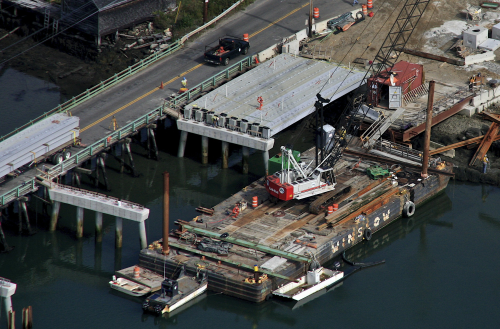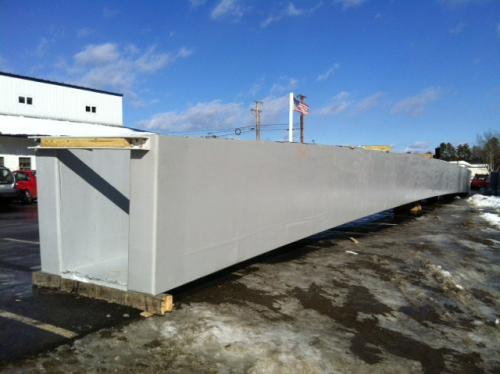

Hybrid beam weighs in
Another infrastructure building technology, the Hybrid Composite Beam (HCB®), reflects similar elements to the Bridge in a Backpack innovation: by combining a structural concrete arch with a steel tension tie and a glass composite shell in a vacuum infusion resin transfer moulding (RTM) process to make a structurally optimised beam, the FRP components serve as permanent formwork, and component handling and installation is relatively quick and cost-effective.
As with Dagher’s technology development, innovation of the HCB took over a decade of concerted engineering persistence by inventor/bridge designer John Hillman.
His company, HC Bridge Co LLC, is based in Wilmette, Illinois, and has worked with construction contractors to install four permanent HCB highway bridges in service, one railroad test bridge, and one marine pier. These installations include the Knickerbocker Bridge in Boothbay, Maine, which is the longest composite vehicular bridge in the world – 163 m (535 ft) and two lanes.
HCB technology is based upon an infusion moulded, quad-knit glass fabric and vinyl ester beam (or rectangular box with integral interior webs) that provides shear strength and encapsulates both the tension and compression structural elements. Concrete fills the FRP beam to provide compression force, while longitudinal steel comprised of high strength prestressing strand provides tension force over the length of the beam and at its two ends.
“Essentially it’s a tied arch in a fibreglass box,” Hillman says, “where 90% of the strength is provided by steel and concrete, and the other 10% of FRP protects these conventional materials from environmental deterioration factors.”
Basic HCB design on the projects to date allows the beams to weigh only a tenth of what precast concrete beams would weigh (2.5 tonnes as compared to 25 tonnes). In the case of the Knickerbocker Bridge, the composite beams tested at four times the minimum requirements for ultimate strength capacity after 2 million cycles of fatigue.
The first prototype beam was fabricated and tested in 2002 at the University of Delaware, Centre for Composite Materials (CCM); an additional eight beams were also tested at CCM that comprised the world’s first railroad bridge, installed in Pueblo, Colorado in 2007.
Subsequent to this proof of concept, additional HCB beams have been manufactured by Harbor Technologies LLC, Brunswick, Maine, in infrastructure projects in Maine, New Jersey, Missouri and Illinois.
Besides the “first” of the Knickerbocker, Hillman notes several others:
- the High Road Bridge over Long Run Creek in Lockport Township, Illinois, is the first commercial highway bridge with a single span of 17.3 m (57 ft) (installed in 2008);
- in Pueblo, Colorado, HCB technology is used in a Burlington Northern and Santa Fe Railroad (BNSF) bridge, the first commercial application of a railroad bridge with a single span of 12.8 m (42 ft). Hillman says this bridge is slated to go into revenue service for BNSF next year;
- the 30.5 m (100 ft) Down East Institute Research Pier built in Machias, Maine, in 2011 is a three-span, all composite pier with concrete filled FRP piles developed by Harbor Technologies, with HCB pier caps and deck sections for the superstructure.
Last November, a 55 m (180 ft) bridge, B0439, using three 18.3 m (60 ft) HCB beams and located just outside Jackson Mill, Missouri, was opened for traffic over Beaver Creek. According to Hillman: “this bridge has integral abutments and is continuous for live load, subsequently making it a jointless bridge.”
The company has two additional bridges underway in Missouri as part of the state’s Safe and Sound Project. The 32 m (106 ft) B0410 bridge is a single span over Sons Creek near Lockwood, and will be completed in May. Bridge B0478 is a two-span bridge with 15.2 m (50 ft) spans that Hillman expects will be completed this June.
Reinforced Plastics: Through commercial project installations, what have you and your partner Michael Zicko learned and incorporated in enhancing hybrid composite beams?
Hillman: Over the course of development, we’ve continued to make improvements in the material layup and infusion process. In some applications we have also gone to multi-cell HCBs fabricated with as many as three internal cells, which allows for wider, united fabrication in a single infusion cycle rather than individual beams tied together with threaded rods. For the Knickerbocker Bridge, we developed a composite top flange over beam placement side by side that eliminates deck forming.
The most recent improvement is the double web box developed for the B0410 Bridge. It resembles a steel tub, or precast U-beam, in that it has two HCBs connected with a monolithic bottom flange. The top flange is still fabricated as a separate piece and gives contractors a wide working platform for tying steel and casting the deck. This allows us to extend the HCB into the 120 foot span range with a box that still only weighs 15 000 lbs (7.5 tonnes).
| The evolution of design codes is somewhat of a double-edged sword. Codes are essential tools in the context of public safety and providing guidance to design engineers to accelerate acceptance of new technology. However, if not used mindfully, they can inhibit an engineer’s creativity and stifle innovation. A careful balance is required. |
|
John Hillman, HC Bridge Co LLC |
When asked if wider, longer HCBs require thicker glass laminate (glass fibre volume in the vinyl ester resin typically ranges from 60-80%), Hillman reports that “in almost every application, we’ve been able to make beams that work with a web thickness of about 5 mm (0.20 inch).”
From a cost perspective, he adds that, in the completed and current ongoing projects, the lighter weight (and hence easier handleability) of the beams has offered “on the order of 75% savings compared to conventional materials in terms of shipping and on-site installation.”
In Hillman’s opinion: “The evolution of design codes is somewhat of a double-edged sword. Codes are essential tools in the context of public safety and providing guidance to design engineers to accelerate acceptance of new technology. However, if not used mindfully, they can inhibit an engineer’s creativity and stifle innovation. A careful balance is required.”
Quest for better function
The infrastructure projects discussed above prove that worthy innovations are rarely an overnight success, and that, often, the academic/industry connection is crucial to R&D that progresses to new commercial products and technology.
Dr Hota GangaRao, Wadesworth professor of civil and environmental engineering, Director for the National Science Foundation and Industry Centre for the Integration of Composites into Infrastructure, and founder/Director of the Constructed Facilities Centre within the College of Engineering and Mineral Resources at the University of West Virginia (WVU), has been conducting FRP research for over 30 years. Focus areas of his R&D include analysis, field testing, and implementation procedures for FRP rebar and other reinforcing components in concrete decks, structural bridge components, and composite wraps bonded to concrete as strengthening elements.
In 1992, GangaRao worked with the US Department of Transportation (DOT) and FHWA and the West Virginia DOT in testing double-trapezoid and hexagonal FRP bridge deck components as an alternative to concrete decking. These experimental elements met the AASHTO deflection criteria for a 9 ft girder spacing and under AASHTO-HS25 load. The design priorities of this project resound with déjà vu to current infrastructure efforts: reduction in dead load by 70%, reduced total construction time and level of on-site equipment required, reduced maintenance, and increased service life.
Most recent innovations coming out of GangaRao’s WVU laboratory encompass design and prototype of prefabricated inspection walkway and modular deck house systems made from pultruded tubular members with unique field joining design/processes; non-load bearing wall panels that have met the ASTM E-119 standard and could be used in construction of schools and residential building; and R&D into plant fibre reinforcement of polymer resins to reduce carbon footprint as compared to glass or carbon fibres.
“This work is producing some thrilling results,” GangaRao reports. “Believe it or not, the stiffness of plant fibre reinforced composites is testing at 15 MSI (while glass is testing at 10 MSI) under certain treatment conditions.”
Work is also ongoing in shape memory polymers, pressure sensitive microbubbles in pigments to identify distress locations, and the potential for higher temperature resin infusion processing to mass produce the most economical and durable composites.
To date, WVU has been involved with 100 field installations of FRP components, including;
-
the bridge decking/composite rebar;
-
railroad bridge stringer members;
-
a bridge walkway system, piles and pile caps; and
-
glass or carbon reinforced bridge column wraps.
Last summer, WVU announced a programme to help the state’s Division of Highways determine which of 400 to 500 deteriorating concrete bridges could benefit from rehabilitative application of the FRP wrap system developed by GangaRao and colleagues.
“This is a major breakthrough for us in terms of field implementation, and will likely take four to five years to complete. Beyond these projects in West Virginia, deficient highways and bridges all across this country in 2010 alone led to a cost of more than €97.5 billion/$129 billion to US households and businesses. Composites can be implemented effectively with little user inconvenience.”
In 1992, GangaRao and WVU colleague Ever J. Barbero published a two-part assessment of structural applications of composites in infrastructure (SAMPE Journal, No. 28, Vol. 1). Their conclusions 20 years later still ring true, and reflect continuing and current efforts with FRP as an innovative material, design and construction alternative to conventional materials.
GangaRao/Barbero: It is recognised that FRP structures cannot be designed as steel or concrete structures. The successful growth of FRP applications hinges upon the development of building and construction systems/design approaches that take into account the complexities of composites, and use them to advantage. Due to a variety of structures requiring different design conditions, geographic dispersion, and the nature of their construction, it is imperative that simple and safe design procedures as well as manufacturing and construction techniques be developed and adopted by the construction community, including the regulatory agencies at various levels, professional organisations, contractors and users. ♦
This article is taken from the feature Infrastructure innovations, which was published in the May/June 2012 issue of Reinforced Plastics magazine. Parts 1 and 2 of this feature are also available on the Reinforced Plastics website (see links in Related Stories section).





